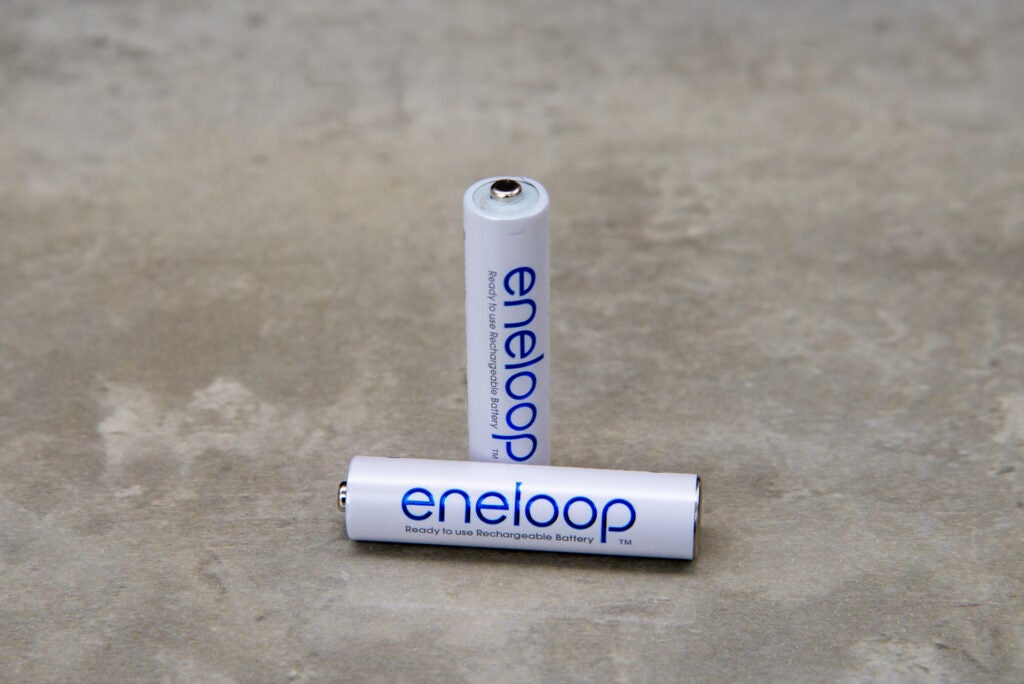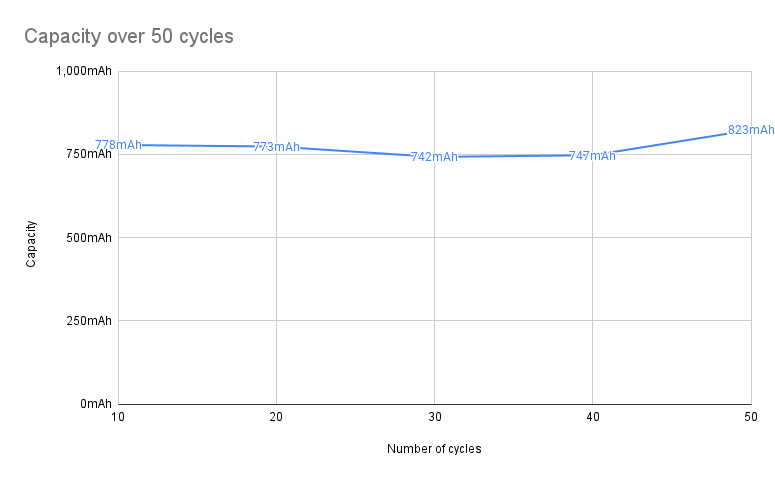Verdict
Capable of holding their charge for up to 10 years, and lasting for thousands of charge cycles, the Eneloop AAA are a great set of rechargeable batteries. They’re particularly well suited to low-drain uses, such as clocks and remote controls.
Pros
- Hold their charge for years
- Stable capacity in my tests
- Can take thousands of charges
-
TypeThese are NiMH rechargeable AAA batteries -
CyclesThese batteries can be charged and drained 2100 times
Introduction
Similar to the Eneloop AA batteries, the Eneloop AAA are the closest that a rechargeable battery will get to an alkaline battery, with a charge retention of 10 years. Factor in the high number of recharge cycles possible with these cells, and the Eneloop AAA are a great choice where longevity is a priority over capacity.
Design and Charges
- Very long-lasting charge
- High number of charge cycles
Standard Eneloop batteries have two things that make them stand out over other NiMH batteries: longevity and charge retention. The Eneloop AAA batteries benefits from both. Rated to retain 70% of their charge after 10 years, these are batteries that you can charge up and stow in a cupboard in the knowledge that they’ll be ready for use when you need them.
This ability to retain charge also means that the Eneloop AAA are a great choice in those scenarios where the ability to hold a charge is more important than capacity. Think of low-drain uses, such as for remote controls.
In addition, these batteries are slated to last for a huge 2100 charge cycles. In effect, you’ll be able to use these batteries for years and years without ever having to worry about replacing them.
On the flip side, the charge rating of 750mAh is one of the lowest I’ve seen for rechargeable batteries. If you have devices that would benefit from greater total capacity – torches, for example – then you may want to look elsewhere.

Performance
- Consistent results
- Good voltage
To see how the batteries performed, I used an Ansmann Energy XC3000 battery tester. First, I measured the Eneloop AAA’s voltage. I recorded 1.29V, which is above the minimum of 1.2V that I’d expect from AAA cells.
Next, I tested the capacity of the batteries using a high-drain test (600mA +/-20%, with a cut-off voltage of 0.94V), and measured them at an initial 778mAh, which is above the minimum rating of 750mAh. I then put the batteries through 50 charge and discharge cycles, taking a capacity reading every 10 cycles. As you can see from the graph below, the results were always above the minimum rating. The standard deviation shows that the variation is within 32mAh of the average.

These tests reinforce the fact that the Eneloop AAA are a great option for those who are looking for longevity from their batteries. If you need more power, then look at rivals such as the GP ReCyko 950 AAA.
Latest deals
These batteries are available in packs of two, four and eight. The four-pack delivers the best combination of value and the likely number of batteries that most people will need.
Should you buy it?
If you need batteries that will hold their charge for a long time – for remote controls, for example – then these are a great option.
If you want more power or cheaper options, then you may be better looking elsewhere.
Final Thoughts
These aren’t the highest-capacity AAA batteries around, nor are they the cheapest. However, if you need reliable batteries that will last for thousands of charges, and hold their charge for a long time, then the Eneloop AAA are a great choice. They really are the closest thing to a set of alkaline AAA batteries that you can buy.
How we test
Unlike other sites, we test every rechargeable battery we review thoroughly over an extended period of time. We use standard tests to compare features properly. We’ll always tell you what we find. We never, ever, accept money to review a product.
Find out more about how we test in our ethics policy.
We use an Ansmann Energy XC 3000 to drain batteries, so that we can test capacity in mAh. After the first run, we charge and discharge 50 times, measuring the capacity every ten runs.
We measure the initial voltage of the batteries, checking that the starting voltage is at least 1.2V.
Trusted Reviews test data
Verdict
Capable of holding their charge for up to 10 years, and lasting for thousands of charge cycles, the Eneloop AAA are a great set of rechargeable batteries. They’re particularly well suited to low-drain uses, such as clocks and remote controls.
Pros
- Hold their charge for years
- Stable capacity in my tests
- Can take thousands of charges
-
TypeThese are NiMH rechargeable AAA batteries -
CyclesThese batteries can be charged and drained 2100 times
Introduction
Similar to the Eneloop AA batteries, the Eneloop AAA are the closest that a rechargeable battery will get to an alkaline battery, with a charge retention of 10 years. Factor in the high number of recharge cycles possible with these cells, and the Eneloop AAA are a great choice where longevity is a priority over capacity.
Design and Charges
- Very long-lasting charge
- High number of charge cycles
Standard Eneloop batteries have two things that make them stand out over other NiMH batteries: longevity and charge retention. The Eneloop AAA batteries benefits from both. Rated to retain 70% of their charge after 10 years, these are batteries that you can charge up and stow in a cupboard in the knowledge that they’ll be ready for use when you need them.
This ability to retain charge also means that the Eneloop AAA are a great choice in those scenarios where the ability to hold a charge is more important than capacity. Think of low-drain uses, such as for remote controls.
In addition, these batteries are slated to last for a huge 2100 charge cycles. In effect, you’ll be able to use these batteries for years and years without ever having to worry about replacing them.
On the flip side, the charge rating of 750mAh is one of the lowest I’ve seen for rechargeable batteries. If you have devices that would benefit from greater total capacity – torches, for example – then you may want to look elsewhere.

Performance
- Consistent results
- Good voltage
To see how the batteries performed, I used an Ansmann Energy XC3000 battery tester. First, I measured the Eneloop AAA’s voltage. I recorded 1.29V, which is above the minimum of 1.2V that I’d expect from AAA cells.
Next, I tested the capacity of the batteries using a high-drain test (600mA +/-20%, with a cut-off voltage of 0.94V), and measured them at an initial 778mAh, which is above the minimum rating of 750mAh. I then put the batteries through 50 charge and discharge cycles, taking a capacity reading every 10 cycles. As you can see from the graph below, the results were always above the minimum rating. The standard deviation shows that the variation is within 32mAh of the average.

These tests reinforce the fact that the Eneloop AAA are a great option for those who are looking for longevity from their batteries. If you need more power, then look at rivals such as the GP ReCyko 950 AAA.
Latest deals
These batteries are available in packs of two, four and eight. The four-pack delivers the best combination of value and the likely number of batteries that most people will need.
Should you buy it?
If you need batteries that will hold their charge for a long time – for remote controls, for example – then these are a great option.
If you want more power or cheaper options, then you may be better looking elsewhere.
Final Thoughts
These aren’t the highest-capacity AAA batteries around, nor are they the cheapest. However, if you need reliable batteries that will last for thousands of charges, and hold their charge for a long time, then the Eneloop AAA are a great choice. They really are the closest thing to a set of alkaline AAA batteries that you can buy.
How we test
Unlike other sites, we test every rechargeable battery we review thoroughly over an extended period of time. We use standard tests to compare features properly. We’ll always tell you what we find. We never, ever, accept money to review a product.
Find out more about how we test in our ethics policy.
We use an Ansmann Energy XC 3000 to drain batteries, so that we can test capacity in mAh. After the first run, we charge and discharge 50 times, measuring the capacity every ten runs.
We measure the initial voltage of the batteries, checking that the starting voltage is at least 1.2V.
























